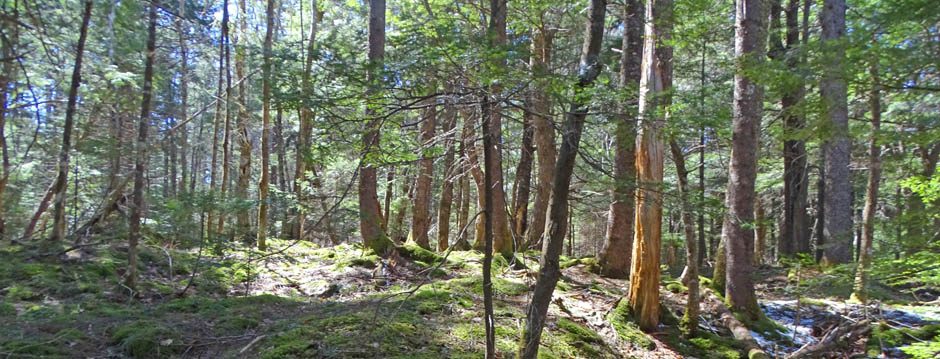For related pages, see Goldsmith Lake Forests & subpages listed there.
——–
 Nina Newington: Why are some of us camping in mud season at the top of a logging road near Goldsmith Lake?
Nina Newington: Why are some of us camping in mud season at the top of a logging road near Goldsmith Lake?
Post on Froends of Goldsmith Lake Wilderness Area Mar 4, 2024.
This letter I sent to Shelly Boone in the Minister of Natural Resources and Renewables Office on the 27th February goes some way to explaining why we feel so passionately about protecting the proposed Goldsmith Lake Wilderness Area, and why we felt so worried when we discovered work happening on a logging road that would give access to some of the cutblocks west of Goldsmith, cutblocks we believed were still on hold.
Ryan McIntyre, DNRR’s Resource Manager for the Western Region, had suddenly stopped responding to emails and phone calls. When he finally did reply it was to direct me to someone in the Minister’s office. To date (March 4) I have not received any response to this letter.
Shelly,
Ryan McIntyre just gave me your email as the person to ask about the holds Natural Resources and Renewables placed on all the harvest plans around Goldsmith Lake touched by species at risk occurrences. That is, AP021210A, AP021211D, AP021212N, AP021213G, AP021015B, AP021015F, AP021209D, and AP021034.
Ryan says some holds have been lifted but he did not specify which. Could you please give me more specific information? Which parcels specifically have been released from the holds? When Ryan and I first communicated about these holds he assured me we would be informed if any of them were lifted. Apparently that has not happened.
These parcels are all within the Goldsmith Lake Wilderness Area, an area proposed for protection by the Citizen Scientists of Southwest Nova Scotia in November 2022. At that point we submitted a proposal with a map defining the area and information about its conservation value to Minister Halman, copied to Minister Rushton. There is a great deal of local support for creating this Wilderness Area and a strong expectation that the ecological value of the area will be kept intact until the area can be given permanent protection as part of the 20%.
Since we submitted the proposal, the Citizen Scientists have continued to document biodiversity in the area as well as enjoying its recreational value. The more time we spend there, the more we realize just how extraordinary it is. We have identified 34 species at risk occurrences to date (with 3 more pending confirmation) within the proposed wilderness area as well as identifying several areas of old growth forest, one stand of which has already been added to NRR’s Old Growth Forest Policy layer. This kind of concentration of rare species and habitats call for conservation of the whole area, not the application of 100m buffers to individual species at risk occurrences.
I am very concerned that your department may not understand the high conservation value of this area and the vulnerability of this diverse ecosystem. The 100 m required buffers around individual lichen occurrences, for example, are intended to be a starting point for conserving these lichens. It is understood that further study should be undertaken and that these buffers may not adequately protect the lichens. This was discovered to be the case with the Boreal Felt Lichen. The lichens died when only a 100m buffer was left. The required buffer in the case of the Boreal Felt lichen was expanded from 100m to 500m. To my knowledge, nobody has yet studied whether 100m buffers are adequate to protect Sclerophora peronella, the Frosted Glass Whiskers lichen we have found in multiple locations around Goldsmith Lake.
It is quite extraordinary to find what we have found to date at Goldsmith Lake. The sort of ecological continuity that has allowed these Frosted Glass Whiskers lichen to establish and survive is extremely rare and precious. There are many areas we have not yet explored, including areas that were approved for harvesting before we had begun to survey for species at risk. We are volunteers, going out at weekends, doing what we can. It was the responsibility of NRR to identify species at risk habitats in the harvest plan areas before approval was granted. The department fell down on its responsibilities there but redeemed itself by putting holds on all those harvest plans touched by species at risk occurrences.
It would be most unfortunate if NRR now took a step backwards and allowed logging to proceed within the proposed Goldsmith Lake Wilderness Area. Local people have been excited to learn about our finds. They have had the opportunity to explore the area by taking part in numerous workshops there in the last year and a half. The unusually accessible old-growth forest is particularly attractive. Plans are underway for Mi’kmaw youth to come and experience old growth forest and to meet the culturally important endangered Black Ash we have identified. For many people, the Goldsmith Lake Wilderness Area is already a reality. It seems unimaginable that NRR would permit logging there now that we all know what a treasure it is.
So please, I urge the department to put the holds back in place and to support the designation of the Goldsmith Lake Wilderness Area.
In the meantime, please let us know exactly which holds are still in place and which have been lifted.
I look forward to your response,
Nina
